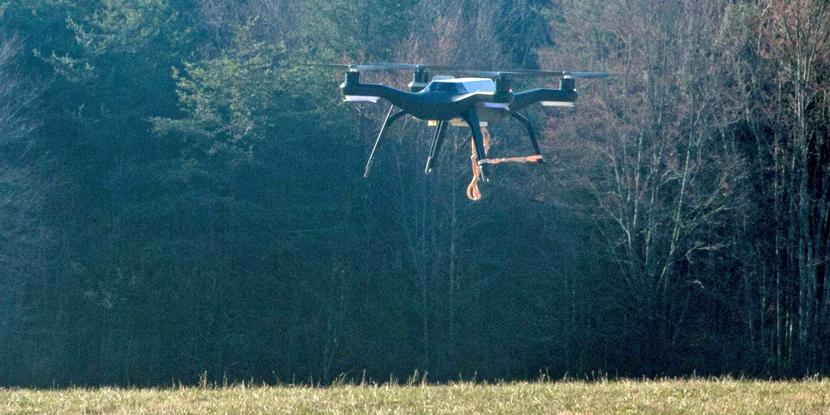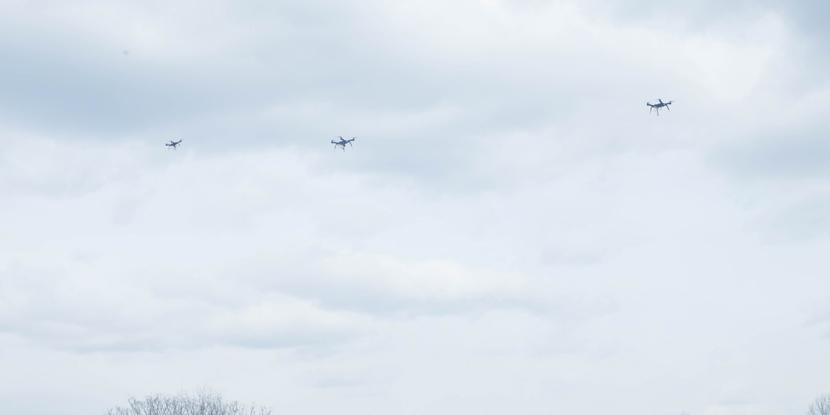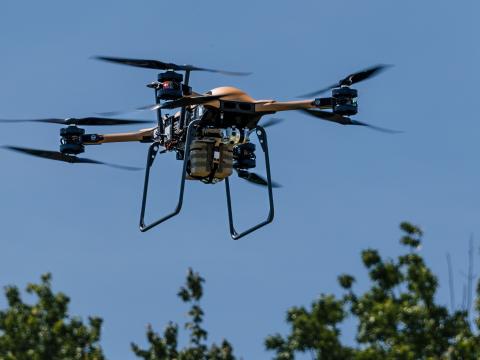The Sky's the Limit for Marine Corps Supply Drones
The U.S. Marine Corps is exploring the use of a family of unmanned aerial vehicles to deliver vital supplies to Marines in combat. Drones would remove humans from the dangerous role of forwarding essential logistics to warfighters while allowing greater flexibility of delivery.
Once developed, these drones also could have civilian emergency response applications. Instead of speeding ammunition to Marines on the front lines, the vehicles would be used to provide emergency supplies to civilians left without power, food or clean water following a natural disaster. Either mission would have the same sense of urgency; only the cargo would be different.
At the heart of this effort is Maj. Christopher R. Thobaben, USMCR, logistics analyst with Installations and Logistics, Headquarters Marine Corps. A reservist, he explains that the genesis for the project came from observing the after effects of earthquakes and cyclonic storms that ravaged the world in the last couple of years. After developing the concept framework for a disaster-relief drone, Maj. Thobaben expanded the capability to suit Marine Corps expeditionary environments.
The Defense Advanced Research Projects Agency (DARPA) and the U.S. Air Force already were producing a similar capability that would provide an autonomous response to an individual Marine’s request for intelligence, surveillance and reconnaissance. Maj. Thobaben’s team tapped that expertise as it slightly manipulated the software code, which cleared the way for the Defense Department’s Rapid Reaction Technology Office to support the team’s pursuit of a proof of concept.
Technology increasingly has made resupply more difficult, despite logistics designed by his organization to support the warfighter, the major says. He notes that the Marines have been working to improve logistics steadily since the world wars. The modern Marine Corps comprises high-value air, sea and ground assets that go along with a trained force carrying out diverse missions. “Long-range, precise munitions are getting to the point now that the static positions—which we’ve grown accustomed to over the past 15 years of fighting nonstate and state actors—are just not going to be tenable much larger than a company or battalion position,” Maj. Thobaben says. “If we have to be mobile, and we have to be decentralized in our operations, how are we going to support it?”
The current state of Marine logistics will not allow the Corps to survive in a future battlespace, let alone fight effectively, he emphasizes. “Right now, our logistics tail can only barely support our current operations where we can do efficient hub-and-spoke linear distribution,” the major continues. “So, the challenge is defining what the future requirements are going to be—taking those steps to define requirements from operational forces and the war-gaming experts—and then designing the logistics system to meet those demands.
“Without a radical change, the Marine Corps will be hamstrung and will culminate far before our objectives are achieved per our current doctrinal applications,” he declares.
Several challenges loom for fully developing the logistics drone. Describing these as vertical challenges involving adjacent technologies, Maj. Thobaben says the technologies are mutually supportive. The airframe itself must be defined, and this presents a host of issues. Many experts question whether so-called autonomous airframes are ready for truly autonomous operation, he contends. The major says he believes they are, but they have not been hardened and readied for remote autonomous employment. “Right now, they are more in the hobby or developmental realm because the civilian infrastructure and power feed are not available for them,” he says. This also applies to autonomous ground and subsurface vehicles, which he describes as being in their infancy for payload and range.
Another vertical challenge is the communications infrastructure. Maj. Thobaben states that the Marine Corps has a well-developed communications infrastructure, but it is configured for large flight platforms. The weight of any related communications equipment would be prohibitive in a small airframe, as it would prevent all but the smallest payload from being carried.
A related challenge is communications security. More digital communications also mean more avenues of approach for an adversary to disrupt the supply chain. Maj. Thobaben points out that this also applies to humanitarian applications that involve nongovernmental organizations, with signal interference posing a potential problem.
An additional issue is software architecture. The Marine Corps’ platform-agnostic software architecture currently is designed to receive demands from a single handheld device in the field autonomously and communicate needs to suppliers that identify and dispatch appropriate assets in response to each demand. But airborne supply drone dispatch and air traffic control deconfliction extend beyond existing capabilities, the major explains. These functions would require more software development as well as the ability to interoperate with crewed airborne platforms.
“We’ve always had a person in the loop,” Maj. Thobaben points out. “Drones have proved extremely efficient and safe with a person in the loop, but where we need to push in terms of high-frequency, real-time response will require us to step away and put a greater deal of trust and confidence in the airframes themselves.”
He adds that the project is meeting that challenge.
Deployment and use of this logistics drone will change the way wars are fought, the major offers. As these drones become an important supply line to forces at the front, adversaries will strive to break that chain in any number of ways. The supply chain is the Corps’ weakness, he says. Marine combatant forces are so powerful and proficient that they can find themselves outrunning their supplies.
“The implications for us are that a combatant commander—battalion level, company level—no longer is tethered to lines of communication for ground, nonmechanized operations,” Maj. Thobaben explains. “If we’re able to satisfy an individual warfighter’s demands and sustain operations beyond the tethers of traditional logistics supply chains … we no longer would have to fight uphill, fight downhill, retreat, resupply, refit and fight back up again. We would take a position, hold it or continue to push past.
“If we can keep up with the logistics demands of our warfighters, then our logistics become a strength, and the logistics of the enemy becomes their weakness,” he continues. “They will still have to be tethered to their high-density, hub-and-spoke, linear distribution models common to modern supply chains.”
Maj. Thobaben says he believes the project is less than a year away from field operations and about 18 months away from supporting Marines in action. Until then, scale will be the dominant issue as the platform is developed. Planners hope for a range of dozens or even hundreds of kilometers and the capacity to conduct thousands of autonomous sorties a day amid crewed aircraft.
Project officials are undertaking a study to determine the ideal mix of platforms. One option is to have three different drones capable of carrying up to 30 pounds, up to 100 pounds and up to 1,000 pounds of cargo, respectively.
The first iteration of drones is expected to consist of only a handful of variations. However, the fleets would modernize through attrition and diversify as they assume more specialized roles. For example, some drones would have heated batteries for cold climes, while others would be larger with higher speeds for decentralized desert operations. “The [unmanned systems] will be as diverse as birds are in different habitats,” Maj. Thobaben offers.
Artificial intelligence (AI) will play a significant role in the drone’s development and evolution, he allows. As AI matures, it will enable the system to become more proficient and more capable. “AI will not just augment the capability of the system to predict demands and facilitate the movement of materiel prior to demand, but it also will be able to outfit a pack of drones,” the major says.
Emphasizing that he envisions a pack of drones rather than a swarm, Maj. Thobaben says the pack would comprise a group of autonomous vehicles, operating adjacent to each other and to other assets, with individual missions. The vehicles would be “organically outfitted” with avoidance capabilities that allow them to complete increasingly complex missions. “AI allows the complexity of those missions to go forward into new environments, including MOUT [military operations on urban terrain] and heavily wooded environments,” he says.
AI also would allow mission complexity to increase, as these drones would progress from delivering goods to one specific point to recognizing where supply recipients are located. The major says he believes this technology will evolve to that point over the next 10 years.
The commercial market will be paramount in this development as it “pushes the bounds” with the Federal Aviation Administration, he continues. The growth of civilian applications for autonomous drones will drive the defense market, which is much smaller than its commercial counterpart.





Comments